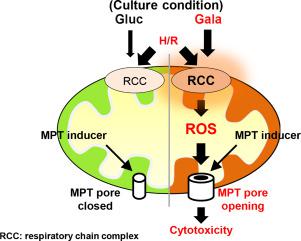当前位置:
X-MOL 学术
›
Toxicol. In Vitro
›
论文详情
Our official English website, www.x-mol.net, welcomes your feedback! (Note: you will need to create a separate account there.)
Hypoxia/reoxygenation exacerbates drug-induced cytotoxicity by opening mitochondrial permeability transition pore: Possible application for toxicity screening.
Toxicology in Vitro ( IF 3.2 ) Pub Date : 2020-05-14 , DOI: 10.1016/j.tiv.2020.104889 Yugo Ikeyama 1 , Tomoyuki Sato 1 , Akinori Takemura 1 , Shuichi Sekine 1 , Kousei Ito 1
Toxicology in Vitro ( IF 3.2 ) Pub Date : 2020-05-14 , DOI: 10.1016/j.tiv.2020.104889 Yugo Ikeyama 1 , Tomoyuki Sato 1 , Akinori Takemura 1 , Shuichi Sekine 1 , Kousei Ito 1
Affiliation

|
Recently, mitochondrial dysfunction is thought of as an important factor leading to a drug-induced liver injury (DILI). Our previous reports show that mitochondria-related toxicity, including respiratory chain inhibition (RCI) and reactive oxygen species (ROS) induction, can be detected by the modification of sugar resource substitution and high oxygen condition. However, this in vitro model does not detect mitochondrial permeability transition (MPT)-induced toxicity. Another study with a lipopolysaccharide-pre-administered rodent model showed that ischemia/reperfusion induced ROS, sensitized the susceptibility of MPT pore opening and, finally developed DILI-like symptoms. Based on this result, the present study investigated the effect of hypoxia/reoxygenation (H/R) treatment mimicking the ischemia/reperfusion on MPT-dependent toxicity, aiming to construct a system that can evaluate MPT by drugs in hepatocytes. Mitochondrial ROS were enhanced by H/R treatment only in the galactose culture condition. Amiodarone, benzbromarone, flutamide and troglitazone, flutamide and, benzbromarone which induced MPT pore opening led to hepatocyte death only in combination with H/R and galactose. Moreover, this alteration was significantly suppressed in hepatocytes lacking cyclophilin D. In conclusion, MPT-induced cytotoxicity can be detected by activating mitochondrial function and H/R. This cell-based assay system could evaluate MPT induced-cytotoxicity by drugs, besides RCI and ROS induction.
中文翻译:

缺氧/复氧通过打开线粒体通透性过渡孔,加剧了药物诱导的细胞毒性:可能用于毒性筛选。
最近,线粒体功能障碍被认为是导致药物性肝损伤(DILI)的重要因素。我们以前的报道表明,通过改变糖资源替代和高氧条件可以检测到与线粒体相关的毒性,包括呼吸链抑制(RCI)和活性氧(ROS)诱导。但是,此体外模型不能检测线粒体通透性转变(MPT)诱导的毒性。另一项使用脂多糖预先给药的啮齿动物模型的研究表明,缺血/再灌注诱导的ROS,使MPT开孔易感性增高,并最终出现类似DILI的症状。基于此结果,本研究调查了模拟缺血/再灌注的缺氧/复氧(H / R)治疗对MPT依赖性毒性的影响,旨在构建一个可以通过肝细胞中的药物评估MPT的系统。仅在半乳糖培养条件下,H / R处理可增强线粒体ROS。导致MPT开孔的胺碘酮,苯并呋喃酮,氟他米特和曲格列酮,氟他米特和苯溴马隆仅与H / R和半乳糖结合才导致肝细胞死亡。此外,这种改变在缺乏亲环蛋白D的肝细胞中得到了显着抑制。总之,可以通过激活线粒体功能和H / R来检测MPT诱导的细胞毒性。这个基于细胞的分析系统除了可以评估RCI和ROS之外,还可以评估药物对MPT诱导的细胞毒性。氟哌丁胺和曲格列酮,氟他酰胺和苯溴马隆仅能与H / R和半乳糖结合使用,导致MPT孔的开放导致肝细胞死亡。此外,这种改变在缺乏亲环蛋白D的肝细胞中得到了显着抑制。总之,可以通过激活线粒体功能和H / R来检测MPT诱导的细胞毒性。除了RCI和ROS诱导以外,这种基于细胞的测定系统还可以评估药物对MPT诱导的细胞毒性。氟哌丁胺和曲格列酮,氟他酰胺和苯溴马隆仅能与H / R和半乳糖结合使用,导致MPT孔的开放导致肝细胞死亡。此外,这种改变在缺乏亲环蛋白D的肝细胞中得到了显着抑制。总之,可以通过激活线粒体功能和H / R来检测MPT诱导的细胞毒性。除了RCI和ROS诱导以外,这种基于细胞的测定系统还可以评估药物对MPT诱导的细胞毒性。
更新日期:2020-05-14
中文翻译:

缺氧/复氧通过打开线粒体通透性过渡孔,加剧了药物诱导的细胞毒性:可能用于毒性筛选。
最近,线粒体功能障碍被认为是导致药物性肝损伤(DILI)的重要因素。我们以前的报道表明,通过改变糖资源替代和高氧条件可以检测到与线粒体相关的毒性,包括呼吸链抑制(RCI)和活性氧(ROS)诱导。但是,此体外模型不能检测线粒体通透性转变(MPT)诱导的毒性。另一项使用脂多糖预先给药的啮齿动物模型的研究表明,缺血/再灌注诱导的ROS,使MPT开孔易感性增高,并最终出现类似DILI的症状。基于此结果,本研究调查了模拟缺血/再灌注的缺氧/复氧(H / R)治疗对MPT依赖性毒性的影响,旨在构建一个可以通过肝细胞中的药物评估MPT的系统。仅在半乳糖培养条件下,H / R处理可增强线粒体ROS。导致MPT开孔的胺碘酮,苯并呋喃酮,氟他米特和曲格列酮,氟他米特和苯溴马隆仅与H / R和半乳糖结合才导致肝细胞死亡。此外,这种改变在缺乏亲环蛋白D的肝细胞中得到了显着抑制。总之,可以通过激活线粒体功能和H / R来检测MPT诱导的细胞毒性。这个基于细胞的分析系统除了可以评估RCI和ROS之外,还可以评估药物对MPT诱导的细胞毒性。氟哌丁胺和曲格列酮,氟他酰胺和苯溴马隆仅能与H / R和半乳糖结合使用,导致MPT孔的开放导致肝细胞死亡。此外,这种改变在缺乏亲环蛋白D的肝细胞中得到了显着抑制。总之,可以通过激活线粒体功能和H / R来检测MPT诱导的细胞毒性。除了RCI和ROS诱导以外,这种基于细胞的测定系统还可以评估药物对MPT诱导的细胞毒性。氟哌丁胺和曲格列酮,氟他酰胺和苯溴马隆仅能与H / R和半乳糖结合使用,导致MPT孔的开放导致肝细胞死亡。此外,这种改变在缺乏亲环蛋白D的肝细胞中得到了显着抑制。总之,可以通过激活线粒体功能和H / R来检测MPT诱导的细胞毒性。除了RCI和ROS诱导以外,这种基于细胞的测定系统还可以评估药物对MPT诱导的细胞毒性。



























 京公网安备 11010802027423号
京公网安备 11010802027423号